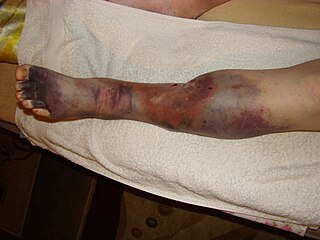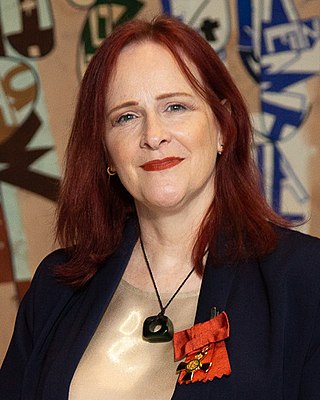Related Research Articles

Fibrinogen is a glycoprotein complex, produced in the liver, that circulates in the blood of all vertebrates. During tissue and vascular injury, it is converted enzymatically by thrombin to fibrin and then to a fibrin-based blood clot. Fibrin clots function primarily to occlude blood vessels to stop bleeding. Fibrin also binds and reduces the activity of thrombin. This activity, sometimes referred to as antithrombin I, limits clotting. Fibrin also mediates blood platelet and endothelial cell spreading, tissue fibroblast proliferation, capillary tube formation, and angiogenesis and thereby promotes revascularization and wound healing.

Von Willebrand disease (VWD) is the most common hereditary blood-clotting disorder in humans. An acquired form can sometimes result from other medical conditions. It arises from a deficiency in the quality or quantity of von Willebrand factor (VWF), a multimeric protein that is required for platelet adhesion. It is known to affect several breeds of dogs as well as humans. The three forms of VWD are hereditary, acquired, and pseudo or platelet type. The three types of hereditary VWD are VWD type 1, VWD type 2, and VWD type 3. Type 2 contains various subtypes. Platelet type VWD is also an inherited condition.

Deep vein thrombosis (DVT) is a type of venous thrombosis involving the formation of a blood clot in a deep vein, most commonly in the legs or pelvis. A minority of DVTs occur in the arms. Symptoms can include pain, swelling, redness, and enlarged veins in the affected area, but some DVTs have no symptoms. The most common life-threatening concern with DVT is the potential for a clot to embolize, travel as an embolus through the right side of the heart, and become lodged in a pulmonary artery that supplies blood to the lungs. This is called a pulmonary embolism (PE). DVT and PE comprise the cardiovascular disease of venous thromboembolism (VTE). About two-thirds of VTE manifests as DVT only, with one-third manifesting as PE with or without DVT. The most frequent long-term DVT complication is post-thrombotic syndrome, which can cause pain, swelling, a sensation of heaviness, itching, and in severe cases, ulcers. Recurrent VTE occurs in about 30% of those in the ten years following an initial VTE.
The American Association for Cancer Research (AACR) is the world's oldest and largest professional association related to cancer research. Based in Philadelphia, the AACR focuses on all aspects of cancer research, including basic, clinical, and translational research into the etiology, prevention, diagnosis, and treatment of cancer. Founded in 1907 by 11 physicians and scientists, the organization now has more than 52,000 members in 130 countries and territories. The mission of the AACR is to prevent and cure cancer through research, education, communication, collaboration, science policy and advocacy, and funding for cancer research.
The American Academy of Sleep Medicine (AASM) is a United States professional society for the medical subspecialty of sleep medicine which includes disorders of circadian rhythms. It was established in 1975.

Post-thrombotic syndrome (PTS), also called postphlebitic syndrome and venous stress disorder is a medical condition that may occur as a long-term complication of deep vein thrombosis (DVT).
The dysfibrinogenemias consist of three types of fibrinogen disorders in which a critical blood clotting factor, fibrinogen, circulates at normal levels but is dysfunctional. Congenital dysfibrinogenemia is an inherited disorder in which one of the parental genes produces an abnormal fibrinogen. This fibrinogen interferes with normal blood clotting and/or lysis of blood clots. The condition therefore may cause pathological bleeding and/or thrombosis. Acquired dysfibrinogenemia is a non-hereditary disorder in which fibrinogen is dysfunctional due to the presence of liver disease, autoimmune disease, a plasma cell dyscrasias, or certain cancers. It is associated primarily with pathological bleeding. Hereditary fibrinogen Aα-Chain amyloidosis is a sub-category of congenital dysfibrinogenemia in which the dysfunctional fibrinogen does not cause bleeding or thrombosis but rather gradually accumulates in, and disrupts the function of, the kidney.

Gundu Hirisave Rama Rao was born in Tumkur (Karnataka), India, on 23 August 1937. He is a scientist, entrepreneur and a tenured professor at the Academic Health Center, University of Minnesota. He and Professor John Eaton visited India in 1981 under a National Science Foundation sponsorship, to explore opportunities for collaborative research projects. They visited medical institutions from Kashmir in the north to Trivandrum in the south. He again visited India during 1990–93, as a professor and a senior consultant for the government of India under a United Nations Development Program (UNDP) called TOKTEN sponsored by the Council of Scientific and Industrial Research. He is a member of the Minneapolis University Rotary ClubArchived 29 September 2011 at the Wayback Machine. He is listed as a Senior Fulbright Scholar in the Roster. He is an active member of Rotary E-Club, RI.3190, Bangalore, India.

Stanley Heptinstall is an Emeritus Professor of the University of Nottingham, Director of Platelet Solutions Ltd, and local government councillor on Nottinghamshire County Council.
Beverley Jane Hunt is professor of thrombosis and haemostasis at King's College, London, consultant in the departments of haematology, rheumatology and pathology and director of the Haemostasis Research Unit at Guy's and St Thomas' Foundation Trust, medical director of Thrombosis UK and previous president of Walthamstow Hall Old Girls Association. She was educated at Walthamstow Hall and University of Liverpool.

Factor I deficiency, also known as fibrinogen deficiency, is a rare inherited bleeding disorder related to fibrinogen function in the blood coagulation cascade. It is typically subclassified into four distinct fibrinogen disorders: afibrinogenemia, hypofibrinogenemia, dysfibrinogenemia, and hypodysfibrinogenemia.
The International Society for Laboratory Hematology (ISLH) is a non-profit organisation founded in 1992. Its purpose is to provide a forum for dissemination of new ideas and information related to the field of laboratory hematology.
Thrombosis Research is an international peer-reviewed medical journal published by Elsevier with a goal of rapid dissemination of new information on thrombosis, hemostasis, and vascular biology to advance science and clinical care. The journal publishes peer-reviewed original research, along with reviews, editorials, and opinions and critics. Both basic and clinical studies are published. Publication of research which will lead to novel approaches in diagnosis, therapy, prognosis and prevention of thrombotic and hemorrhagic diseases is given high priority.
Jerrold H. Levy is an American critical care physician and cardiac anesthesiologist at Duke University Medical Center who currently serves as the Co-Director of Duke's Cardiothoracic Intensive Care Unit. He is most noted for his research in surgical hemostasis, coagulopathy in the critically ill, shock, anaphylaxis, and developing purified and recombinant therapeutic approaches to treat bleeding. He has authored over 400 publications, including scientific manuscripts, review articles, editorials, books, and book chapters. His research manuscripts are available on PubMed. Additionally, he has authored a number of websites aimed at providing medical information to healthcare professionals through his website, DocMD.

The International Committee for Standardization of Hematology (ICSH) was initiated by the European Society of Hematology (ESH) in 1963. As the Committee for Standardization, the International Society of Hematology (ISH) and ESH were formally established in Stockholm in 1964. ICSH is a non-governmental organization recognized as having formal relations with the World Health Organization (WHO). At the same time, ICSH is a non-profit organization that aims to obtain reliable and repeatable results in laboratory analysis in the field of hematological diagnosis. The basic goal of ICSH is to obtain reliable and repeatable results in the laboratory, mainly involving diagnostic hematology. All guidelines and recommendations now include the appropriate level of evidence. ICSH Coordination Expert Working Group reviews laboratory methods and tools for blood analysis, considers standardization issues, and promotes and coordinates scientific work in the development of international standardized materials and guidelines.

Dominique Meyer is a French M.D. biologist and member of the French Academy of Sciences.

Mary Cushman is an American vascular hematologist. She is a Full professor of Medicine and Pathology in the Robert Larner College of Medicine at the University of Vermont.
Henri Bounameaux is a known clinical faculty and Professor of Medicine (hon), specialized in internal and vascular medicine (angiology), and general medicine.

Marie Claire McLintock was a New Zealand haematologist and obstetric physician. She was an expert in medical conditions and disorders related to bleeding and blood clotting, and medical problems associated with pregnancy.
References
- ↑ ISTH (2015). "ISTH History" . Retrieved 2015-11-19.
- ↑ ISTH (2015). "About ISTH" . Retrieved 2015-11-19.
- ↑ ISTH (2015). "SSC" . Retrieved 2015-11-19.
- ↑ ISTH (2015). "Academy" (PDF). Retrieved 2015-11-19.
- ↑ "Past ISTH Council Leaders". ISTH. Retrieved December 27, 2022.